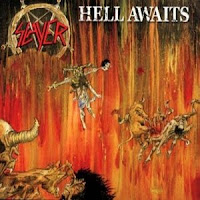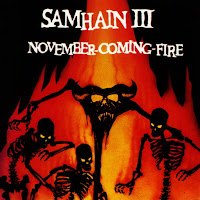Si Monumentum Requires, Circumspice (2004)
When I was a Christian, there were certain records and certain bands that seemed "possessed" to me, as if the sacred or profane were speaking through the musicians. Of course, I no longer believe in the supernatural, but I do think there are some artists who may occasionally tap into human experience and emotions in ways that surpass most other creative endeavors. Many of the albums I've discussed do not actually approve of the gimmicks they sell. Nick Cave does not encourage murder, Slayer doesn't really worship Satan, and Black Sabbath probably don't endorse the occult. Deathspell Omega is an entirely different matter.
Despite their somewhat comical name, the band is very serious about its music. So serious, in fact, that its members have chosen to remain anonymous in the hopes of putting the focus on the music rather than the musicians. What is known about them, and what is widely confessed in their lyrics and imagery, is that they are Satanists. No, not like Slayer; not even like Anton LaVey and other so-called satanists who are basically atheists under another name. The members of Deathspell Omega are theistic Satanists, meaning that they do believe in a "being" called Satan. But this is not the same Satan envisioned in Protestant Christianity, and it may not even be accurate to call it a "being." From what I've gathered out of lyrics and interviews, the Satanism of Deathspell Omega is an interesting blend of gnostic, hermetic, Abrahamic, Qabalistic, and various occult beliefs. They regard Yahweh/Jesus as the demiurge - a misguided, or harmful, and deluded being that created this universe - while Satan is seen as the figurehead among 11 deities that are all manifestations of the true god, who rules the realm of Chaos, into which our universe will some day be subsumed.
Si Monumentum Requires, Circumspice is Latin that translates to: "If you seek His monument, look around you." Latin is used several times throughout the album, not only in song titles, but in lyrics as well. The first track is one of three prayers that serve as introductions and interludes. These prayers are predominantly instrumental, though a couple feature ominous chanting. "First Prayer" is accompanied by a picture in the CD insert of a horrendously emaciated man, arms outstretched, as the invocation is delivered:
Lungs filled with embers and regurgitating boiling blood
I say Praise the Lord, praise, O servants of the Lord...
We will sing a new song to thee, O God:
A psaltery of thirteen Stations,
May scoria bury Eden and blind the light of hope...
With the first actual song, "Sola Fide," (faith alone) we enter into the morbid chasm of a new breed of black metal. Here, minimalism is no concern, and so the music walks a fairly progressive line for the genre, while the production is a slightly murky one that manages both to suit the darkly abrasive style of music and to be clear enough to be audible and enjoyable. The compositions feature blistering blast-beats as well as mid-tempo hooks, dissonant doom rhythms, and slow, demented sounding melodies. Ambient effects and even choral arrangements are worked in at a few points too, as Deathspell Omega defies genre expectations in pursuit of their message.
Speaking of that, if you're interested to try and decipher the message of Si Monumentum, be sure to have a philosophy dictionary and a theology textbook ready. Many of the lyrics will appear confusing and obscure to those who aren't familiar with the beliefs I mention above, but if one thing is certain, it would be that the album is dead sincere in its blasphemy and its praise of evil. "Blessed is he that taketh rewarde to slea the soule of innocent bloude," the third prayer says. "Blessed is he that murders Christ in himself and in his fellow men."
A review of this brevity can't do justice to this record. It flirts with insanity, depravity, and every dark, disgusting, and depressing thing. Undoubtedly, Si Monumentum is best experienced as a whole; if you listen to it, make sure you hear it in its entirety the first time. This is the first installment of the band's trilogy relating to god, Satan, and man's relationship with the two. The follow-up, Fas, descends rapidly into chaotic madness unlike anything most of us have heard, and the final part of the trilogy, Paracletus, reaches a staggering resolution between the two previous works.
For their intelligent lyrics, unique and unholy music, and uncompromising devotion to their art, I have to consider Deathspell Omega among my top three favorite bands. If there is one record ripe for any wicked occasion, for me it's Si Monumentum. The darkness of it may be a bit much for some, but those who are open to an unforgiving musical experience crafted in the furthest void of Chaos might find a lot to enjoy here.












